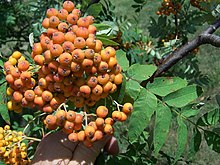The tree species Sorbus americana is commonly known as the American mountain-ash.[4] It is a deciduous perennial tree, native to eastern North America.[5]
| American mountain-ash | |
|---|---|

| |
| Scientific classification | |
| Kingdom: | Plantae |
| Clade: | Tracheophytes |
| Clade: | Angiosperms |
| Clade: | Eudicots |
| Clade: | Rosids |
| Order: | Rosales |
| Family: | Rosaceae |
| Genus: | Sorbus |
| Section: | Sorbus sect. Commixtae |
| Species: | S. americana
|
| Binomial name | |
| Sorbus americana | |

| |
| Distribution map of native Sorbus americana range. | |
| Synonyms[3] | |
The American mountain-ash and related species (most often the European mountain-ash, Sorbus aucuparia) are also referred to as rowan trees.
Description
editSorbus americana is a relatively small tree, reaching 12 metres (40 ft) in height.[5] The American mountain-ash attains its largest specimens on the northern shores of Lake Huron and Lake Superior.[6]
It resembles the European mountain-ash, Sorbus aucuparia.
- Bark
- Light gray, smooth, surface scaly. Branchlets downy at first, later become smooth, brown tinged with red, lenticular, finally they become darker and the papery outer layer becomes easily separable.
- Wood
- Pale brown; light, soft, close-grained but weak. Specific gravity, 0.5451; weight of cu. ft., 33.97 lbs.
- Winter buds
- Dark red, acute, one-fourth to three-quarters of an inch long. Inner scales are very tomentose and enlarge with the growing shoot.
- Leaves
- Alternate, compound, odd-pinnate, 6 to 10 inches (15 to 25 cm) long, with slender, grooved, dark green or red petiole. Leaflets 13 to 17, lanceolate or long oval, two to three inches long, one-half to two-thirds broad, unequally wedge-shaped or rounded at base, serrate, acuminate, sessile, the terminal one sometimes borne on a stalk half an inch long, feather-veined, midrib prominent beneath, grooved above. They come out of the bud downy, conduplicate; when full grown are smooth, dark yellow green above and paler beneath. In autumn they turn a clear yellow. Stipules leaf-like, caducous.
- Flowers
- May, June, after the leaves are full grown. Perfect, white, one-eighth of an inch across, borne in flat compound cymes three or four inches across. Bracts and bractlets acute, minute, caducous.
- Calyx
- Urn-shaped, hairy, five-lobed; lobes, short, acute, imbricate in bud.
- Corolla
- Petals five, creamy white, orbicular, contracted into short claws, inserted on calyx, imbricate in bud.
- Stamens
- Twenty to thirty, inserted on calyx tube; filaments thread-like; anthers introrse, two-celled; cells opening longitudinally.
- Pistil
- Two to three carpels inserted in the bottom of the calyx tube and united into an inferior ovary. Styles two to three; stigmas capitate; ovules two in each cell.
- Fruit
- Berry-like pome, globular, one-quarter of an inch across, bright red, borne in cymous clusters. Ripens in October and remains on the tree all winter. Flesh thin and sour, charged with malic acid; seeds light brown, oblong, compressed; cotyledons fleshy.[6]
Distribution
editNative to eastern North America;
- Eastern Canada – New Brunswick, Newfoundland, Nova Scotia, Ontario, Prince Edward Island, Quebec[7]
- Northeastern United States[8] – Connecticut, Maine, Massachusetts, New Hampshire, New Jersey, New York, Pennsylvania, Vermont
- North-Central United States – Illinois [n. (Ogle Co.)], Michigan, Minnesota, Wisconsin. Listed as endangered by the State of Illinois[9]
- Southeastern United States – Appalachian Mountains, Georgia, Maryland, North Carolina, Tennessee, Virginia, West Virginia
Biota
editThe berries of American mountain-ash are eaten by numerous species of birds, including ruffed grouse, ptarmigans, sharp-tailed grouse, blue grouse, American robins, other thrushes, waxwings, jays, and small mammals, such as squirrels and rodents.[10]
American mountain-ash is a preferred browse for moose and white-tailed deer. Moose will eat foliage, twigs, and bark. Up to 80 percent of American mountain-ash stems were browsed by moose in control plots adjacent to exclosures on Isle Royale. Fishers, martens, snowshoe hares, and ruffed grouse also browse American mountain-ash.[10]
Cultivation
editSorbus americana is cultivated as an ornamental tree, for use in gardens and parks. It prefers a rich moist soil and the borders of swamps, but will flourish on rocky hillsides.
A cultivar is the red cascade mountain-ash, or Sorbus americana 'Dwarfcrown'. It is planted in gardens, and as a street tree.[11]
Uses
editAfter their first winter freeze, the fruits are edible raw or cooked. They can be used to make pie and jelly.[12]
References
edit- ^ Botanic Gardens Conservation International (BGCI).; IUCN SSC Global Tree Specialist Group (2018). "Sorbus americana". IUCN Red List of Threatened Species. 2018: e.T135956666A135956668. doi:10.2305/IUCN.UK.2018-2.RLTS.T135956666A135956668.en. Retrieved 19 November 2021.
- ^ "ITIS Standard Report Page: Sorbus americana". www.itis.gov.
- ^ "Sorbus americana". Tropicos. Missouri Botanical Garden.
- ^ "Conservation Plant Characteristics for ScientificName (CommonName) - USDA PLANTS". plants.usda.gov.
- ^ a b McAllister, H.A. (2005). The genus Sorbus: Mountain Ash and other Rowans. Kew Publishing.
- ^ a b Keeler, Harriet L. (1900). Our Native Trees and How to Identify Them. New York: Charles Scribner's Sons. pp. 136–140.
- ^ "Sorbus americana". Germplasm Resources Information Network. Agricultural Research Service, United States Department of Agriculture.
- ^ "Sorbus americana — American mountain-ash". Go Botany. Native Plant Trust. Retrieved November 19, 2024.
- ^ "Threatened Search Results - USDA PLANTS". plants.usda.gov.
- ^ a b "Sorbus americana". www.fs.fed.us.
- ^ "Urban Forest Nursery: Tree Profile for the Red Cascade Mountain Ash". www.urbanforestnursery.com. Retrieved January 31, 2013.
- ^ Elias, Thomas S.; Dykeman, Peter A. (2009) [1982]. Edible Wild Plants: A North American Field Guide to Over 200 Natural Foods. New York: Sterling. p. 240. ISBN 978-1-4027-6715-9. OCLC 244766414.
External links
edit- USDA, NRCS (n.d.). "Sorbus americana". The PLANTS Database (plants.usda.gov). Greensboro, North Carolina: National Plant Data Team.
- Sorbus americana – picture of young tree, and complete summary data
- Interactive Distribution Map for Sorbus americana
